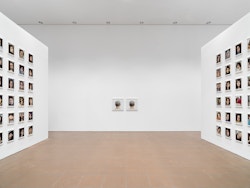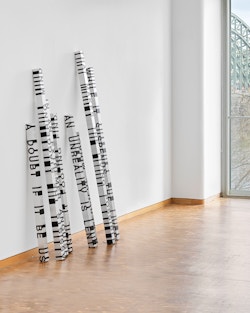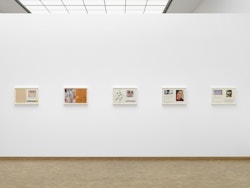Roni Horn
Give Me Paradox or Give Me Death
23 March—11 August 2024
Museum Ludwig, Cologne, Germany
Museum Ludwig is pleased to present Roni Horn: Give Me Paradox or Give Me Death, a solo exhibition of works by influential American artist Roni Horn. The exhibition includes over 100 works, spanning from the beginning of the artist’s decades long career to present day. Roni Horn's oeuvre includes sculpture, photography, drawing and artist's books. The title of the exhibition goes back to Patrick Henry, an outstanding representative of the American independence movement in the 18th century, who ended a speech with the famous words: “Give me liberty, or give me death!” By replacing liberty with paradox, the artist nods to her interest in the reconciliation of two contradictory answers, an important aspect in her work, which also relates to her use of doubling or pairs.
Upon entering the exhibition, viewers are greeted by This is Me, This is You (1997-2000), a photographic work installed on two opposing walls. Each wall contains 48 framed photographs of the artist’s niece, which were taken over a two-year period during her adolescence. Every photograph corresponds with one on the opposing wall, showing subtle changes between split seconds. As she explains in a 1989 interview, “The pair form, by virtue of the condition of being double, actively refuses the possibility of being experienced as a thing in itself.” Here, Horn not only employs doubles or pairs, but also speaks to identity’s constant flux.

Yilmaz Dziewior, curator of the exhibition, comments, “Roni Horn began exploring fluid representations of gender long before terms such as genderqueer and nonbinary entered public discourse. In her (self-)portraits, you see a person who fluctuates between genders without needing to find a specific term to describe this mode of being. She shows humans as organisms constantly manifesting themselves in a state of perpetual transformation. While extremely precise and highly aesthetic, her objects, photographs, and drawings have a liberating and emancipatory potential because they are often intangible and indefinable.”
Moving through the exhibition, viewers will encounter never before exhibited drawings from the late 1970s, in addition to a selection of pigment drawings produced between 1983 and 2018. Photographic works on view include the seminal work Still Water (The River Thames, for Example) (1999), comprised of 15 photographs which act as a portrait of the River Thames in Southern England; a.k.a. (2008-09), which depicts the artist at different moments throughout her life, and Portrait of an Image (with Isabelle Huppert) (2005-06), where Horn has photographed actress Isabelle Huppert posing as characters from her films.
Sculptures in the exhibition include works from the series When Dickinson Shut Her Eyes (1993-2008), where Horn has recreated poems by Emily Dickinson; Gold Field (1980/1994), a work composed of 99.99% gold foil; and Untitled (“The tiniest piece of mirror is always the whole mirror.”) (2022), a ten-unit solid cast glass work that reflects its surrounding environment.



